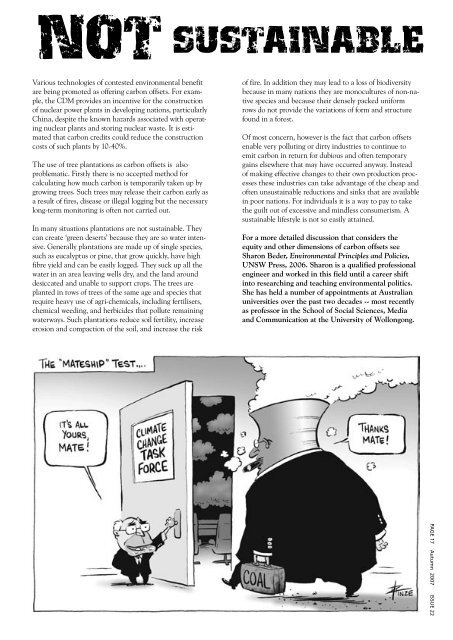news & views - Australian Greens
news & views - Australian Greens
news & views - Australian Greens
Create successful ePaper yourself
Turn your PDF publications into a flip-book with our unique Google optimized e-Paper software.
NOT SUSTAINABLE<br />
Various technologies of contested environmental benefit<br />
are being promoted as offering carbon offsets. For example,<br />
the CDM provides an incentive for the construction<br />
of nuclear power plants in developing nations, particularly<br />
China, despite the known hazards associated with operating<br />
nuclear plants and storing nuclear waste. It is estimated<br />
that carbon credits could reduce the construction<br />
costs of such plants by 10-40%.<br />
The use of tree plantations as carbon offsets is also<br />
problematic. Firstly there is no accepted method for<br />
calculating how much carbon is temporarily taken up by<br />
growing trees. Such trees may release their carbon early as<br />
a result of fires, disease or illegal logging but the necessary<br />
long-term monitoring is often not carried out.<br />
In many situations plantations are not sustainable. They<br />
can create ‘green deserts’ because they are so water intensive.<br />
Generally plantations are made up of single species,<br />
such as eucalyptus or pine, that grow quickly, have high<br />
fibre yield and can be easily logged. They suck up all the<br />
water in an area leaving wells dry, and the land around<br />
desiccated and unable to support crops. The trees are<br />
planted in rows of trees of the same age and species that<br />
require heavy use of agri-chemicals, including fertilisers,<br />
chemical weeding, and herbicides that pollute remaining<br />
waterways. Such plantations reduce soil fertility, increase<br />
erosion and compaction of the soil, and increase the risk<br />
of fire. In addition they may lead to a loss of biodiversity<br />
because in many nations they are monocultures of non-native<br />
species and because their densely packed uniform<br />
rows do not provide the variations of form and structure<br />
found in a forest.<br />
Of most concern, however is the fact that carbon offsets<br />
enable very polluting or dirty industries to continue to<br />
emit carbon in return for dubious and often temporary<br />
gains elsewhere that may have occurred anyway. Instead<br />
of making effective changes to their own production processes<br />
these industries can take advantage of the cheap and<br />
often unsustainable reductions and sinks that are available<br />
in poor nations. For individuals it is a way to pay to take<br />
the guilt out of excessive and mindless consumerism. A<br />
sustainable lifestyle is not so easily attained.<br />
For a more detailed discussion that considers the<br />
equity and other dimensions of carbon offsets see<br />
Sharon Beder, Environmental Principles and Policies,<br />
UNSW Press, 2006. Sharon is a qualified professional<br />
engineer and worked in this field until a career shift<br />
into researching and teaching environmental politics.<br />
She has held a number of appointments at <strong>Australian</strong><br />
universities over the past two decades -- most recently<br />
as professor in the School of Social Sciences, Media<br />
and Communication at the University of Wollongong.<br />
PAGE 17 Autumn 2007 ISSUE 22












